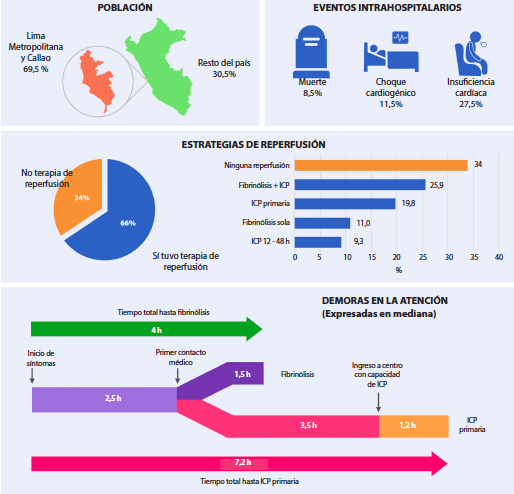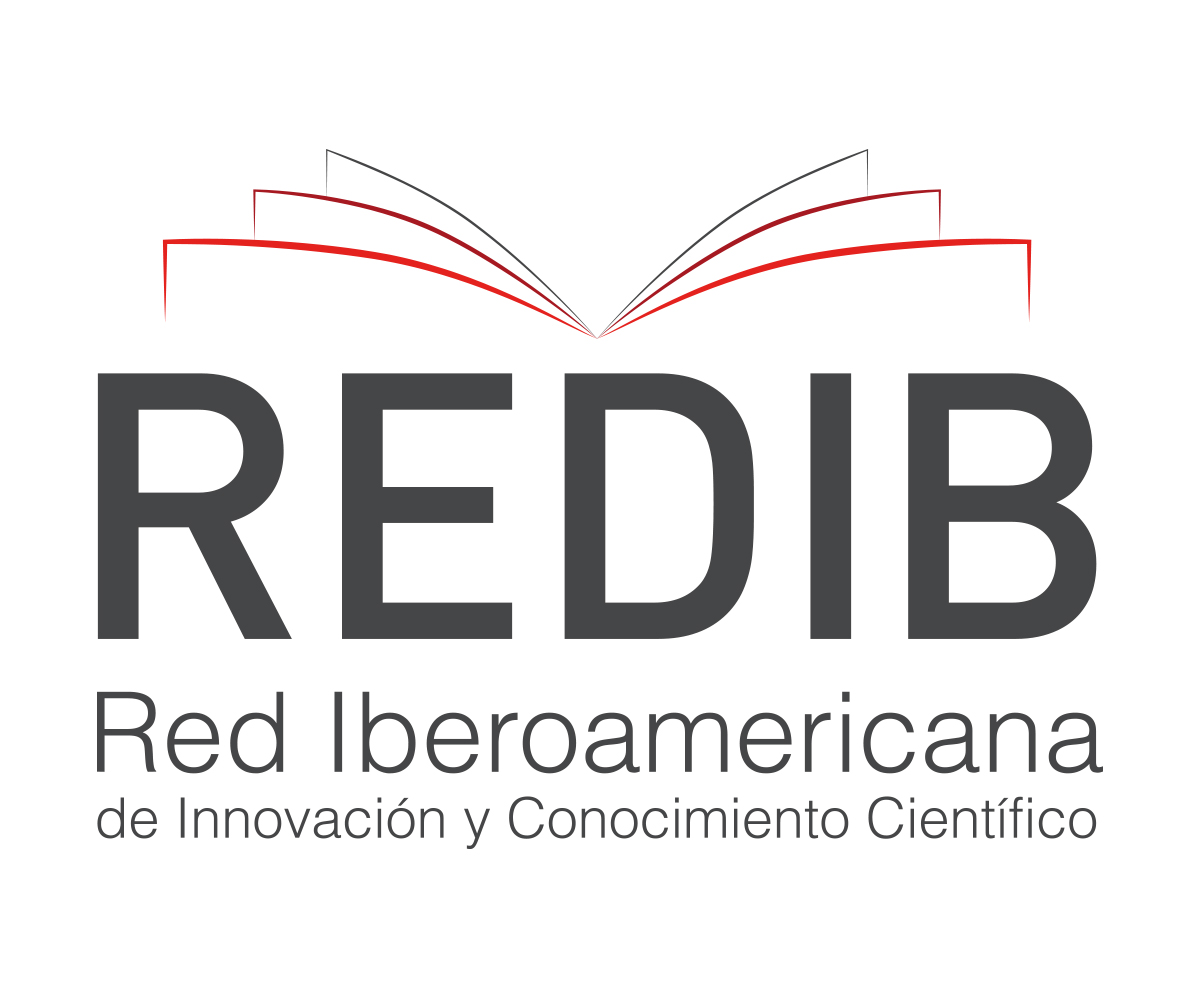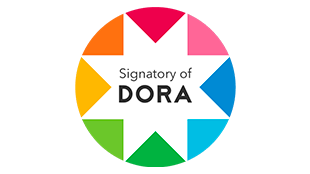Treatment of acute myocardial infarction in Peru and its relationship with in-hospital adverse events: results from the Second Peruvian Registry of ST-segment elevation myocardial infarction (PERSTEMI-II).
DOI:
https://doi.org/10.47487/apcyccv.v2i2.132Keywords:
Myocardial infarction, fibrinolysis, angioplasty, mortality, heart failure, PeruAbstract
Background. ST-segment elevation myocardial infarction (STEMI), is an important cause of morbidity and mortality worldwide, and myocardial reperfusion, when adequate, reduces the complications of this entity. The aim of the study was to describe the clinical and treatment characteristics of STEMI in Peru and the relationship of successful reperfusion with in-hospital adverse events. Materials and methods. Prospective, multicenter cohort of STEMI patients attended during 2020 in public hospitals in Peru. We evaluated the clinical, therapeutic characteristics and in-hospital adverse events, also the relationship between successful reperfusion and adverse events. Results. A total of 374 patients were included, 69.5% in Lima and Callao. Fibrinolysis was used in 37% of cases (pharmacoinvasive 26% and alone lysis 11%), primary angioplasty with < 12 hours of evolution in 20%, late angioplasty in 9% and 34% did not access adequate reperfusion therapies, mainly due to late presentation. Ischemia time was longer in patients with primary angioplasty compared to fibrinolysis (median 7.7 hours (RIQ 5-10) and 4 hours (RIQ 2.3-5.5) respectively). Mortality was 8.5%, the incidence of post-infarction heart failure was 27.8% and of cardiogenic shock 11.5%. Successful reperfusion was associated with lower cardiovascular mortality (RR:0.28; 95%CI: 0.12-0.66, p=0.003) and lower incidence of heart failure during hospitalization (RR: 0.61; 95%CI: 0.43-0.85, p=0.004). Conclusions. Fibrinolysis continues to be the most frequent reperfusion therapy in public hospitals in Peru. Shorter ischemia-to-reperfusion time was associated with reperfusion success, and in turn with fewer in-hospital adverse events.
Downloads
References
World Health Statistics 2011. WHO’s annual compilation of data from its 193 Member States, including a summary of progress towards the health-related Millennium Development Goals and Targets. Disponible en: http://www.who.com
Lloyd-Jones D, Adams R, Carnethon M, et al. Heart disease and stroke statistics—2009 update: a report from the American Heart Association Statistics Committee and Stroke Statistics Subcommittee. Circulation. 2009;119: e21-181. DOI: 10.1161/CIRCULATIONAHA.108.191261
O’Gara PT, Kushner FG, Ascheim DD, et al. 2013 ACCF/AHA guideline for the management of ST-elevation myocardial infarction: a report of the American College of Cardiology Foundation/American Heart Association Task Force on Practice Guidelines. J Am Coll Cardiol 2013;61: e78 –140. DOI: 10.1016/j.jacc.2012.11.019
Gharacholou SM, Alexander KP, Chen AY, et al. Implications and reasons for the lack of use of reperfusion therapy in patients with ST-segment elevation myocardial infarction: findings from the CRUSADE initiative. Am Heart J. 2010; 159:757– 63. DOI: 10.1016/j.ahj.2010.02.009
Fuster V, Badimon L, Badimon JJ, Chesebro JH. The pathogenesis of coronary artery disease and the acute coronary syndromes (part I). N Engl J Med.1992;326:242-50, 310-8. DOI: 10.1056/NEJM199201233260406
Ibañez B, James S, Agewall S, et al. Management of acute myocardial infarction in patients presenting with persistent ST segment elevation: the Task Force on the Management of ST segment elevation acute myocardial infarction of the European Society of Cardiology. Eur Heart J. 2017; 29:2909-45.
Gagliardi J, CAHARASK A, Perna E, et al. Encuesta nacional de infarto agudo de miocardio con elevación del segmento ST en la República Argentina (ARGEN-IAM-ST) Rev Argent Cardiol 2016; 84:548-57 DOI: http://dx.doi.org/10.7775/rac.es.v84.i6.9508
García A, Jerjes-Sánchez C, Martínez BP, et al. Renasica II. Un registro mexicano de los síndromes coronarios agudos. Arch Cardiol Mex. 2005;75(supl 2) S6-S19.
Chacón M, Vega A, Aráoz O, et al. Características epidemiológicas del infarto de miocardio con elevación del segmento ST en Perú: resultados del PEruvian Registry of ST-segment Elevation Myocardial Infarction (PERSTEMI). Arch Cardiol Mex. 2018; 88(5):403-12. DOI: 10.1016/j.acmx.2017.11.009
Higa CC, D´Imperio H, Blanco P, et al. Comparación de dos registros argentinos de infarto de miocardio: SCAR 2011 y ARGEN-IAM ST 2015. Rev Argent Cardiol. 2019;87:19-25. DOI: 10.7775/rac.es.v87.i1.14515.
Brindis RG, Bates ER, Henry TD. Value of Registries in ST-Segment-Elevation Myocardial Infarction Care in Both the Pre-Coronavirus Disease 2019 and the Coronavirus Disease 2019 Eras. J Am Heart Assoc. 2021;10:e019958. DOI: 10.1161/JAHA.120.019958.
Custodio-Sánchez P, Miranda D, Murillo L. Impacto de la Pandemia por COVID-19 sobre la Atención del Infarto de Miocardio ST Elevado en el Perú. Arch Peru Cardiol Cir Cardiovasc. 2020;1:87-94. DOI: 10.47487/apcyccv.v1i2.22.
Rodriguez-Leor O, Cid-Álvarez B, Ojeda S, et al. Impacto de la pandemia de COVID-19 sobre la actividad asistencial en cardiología intervencionista en España. REC Interv Cardiol. 2020;2:82-89. DOI: 10.24875/RECIC.M20000120.
Garcia S, Albaghdadi M, Meraj P, et al. Reduction in ST-Seg-ment Elevation Cardiac Catheterization Laboratory Activations in the United States during COVID-19 Pandemic. J Am Coll Cardiol. 2020;75(22):2871-72. DOI: 10.1016/j.jacc.2020.04.011.
D´Imperio H, Gagliardi J, Charask A, et al. Infarto agudo de miocardio con elevación del segmento ST en la Argentina. Datos del registro continuo ARGEN-IAM-ST. Rev Argen Cardiol. 2020;88:297-307. DOI: 10.7775/rac.es.v88.i4.18501.
Filgueiras NM, Feitosa GS, Fontoura DJ, et al. Implementation of a Regional Network for ST-Segment-Elevation Myocardial Infarction (STEMI) Care and 30-Day Mortality in a Low-to Middle-Income City in Brazil: Findings From Salvador´s STEMI Registry (RESISST). J Am Heart Assoc. 2018;7:e008624. DOI: 10.1161/JAHA.118.008624.
Alves L, Polanczyk CA. Hospitalization for Acute Myocardial Infarction: A Population-Based Registry. Arq Bras Cardiol. 2020;115:916-924. DOI: 10.36660/abc.20190573.
Martinez-Sanchez C, Borrayo G, Carrillo J, et al. Clinical management and hospital outcomes of acute coronary syndrome patients in Mexico: The Third National Registry of Acute Coronary Syndromes (RENASICA III). Arch Cardiol Mex. 2016;86:221-232. DOI: 10.1016/j.acmx.2016.04.007.
Araiza-Garaygordobil D, Gopar-Nieto R, Cabello-López A. Pharmacoinvasive Strategy vs Primary Percutaneous Coronary Intervention in Patients With ST-Elevation Myocardial Infarction: Results From a Study in Mexico City. CJC Open. 2021;3:409-418.
Farré N, Fort A, Tizón-Marcos H, et al. Epidemiology of heart failure in myocardial infarction treated with primary angioplasty: Analysis of the Codi IAM registry. REC Cardio Clin. 2019;54:41-49. DOI: 10.1016/j.rccl.2019.01.014.
Guzmán-Rodríguez R, Polo-Lecca G, Aráoz-Tarco O, et al. Características Actuales y Factores de Riesgo de Mortalidad en Choque Cardiogénico por Infarto de Miocardio en un Hospital Latinoamericano. Arch Peru Cardiol Cir Cardiovasc. 2021;2:35-43. DOI: 10.47487/apcyccv.v2i1.89.
Zeymer W, Bueno H, Granger CB, et al. Acute Cardiovascular Care Association position statement for the diagnosis and treatment of patients with acute myocardial infarction complicated by cardiogenic shock: A document of the Acute Cardiovascular Care Association of the European Society of Cardiology. Eur Heart J Acute Cardiovasc Care. 2020;9:183-197. DOI: 10.1177/2048872619894254.
Belle L, Cayla G, Cottin Y, et al. French Registry on Acute ST-elevation and non−ST-elevation Myocardial Infarction 2015 (FAST-MI 2015). Design and baseline data. Arch Cardiovasc Dis. 2017;110:366-378. DOI: 10.1016/j.acvd.2017.05.001.
American College of Emergency Physicians. Public Poll: Emergency Care Concerns amidst COVID-19. US: ACEP. 2020. Disponible en: https://www.emergencyphysicians.org/article/covid19/public-poll-emergency-care-concerns-amidst-covid 19.
Tam C, Cheung K, Lam S, et al. Impact of Coronavirus Disease 2019 (COVID-19) Outbreak on ST-Segment-Elevation Myocar-dial Infarction Care in Hong Kong, China. Circ Cardiovasc Qual Outcomes. 2020;13(4):1-3. DOI: 10.1161/CIRCOUTCOMES.120.006631.
Jing ZC, Zhu HD, Yan XW, et al. Recommendations from the Peking Union Medical College Hospital for the management of acute myocardial infarction during the COVID-19 outbreak. Eur Heart J. 2020;41:1791-1794. DOI: 10.1093/eurheartj/ehaa258.
De Luca G, Verdoia M, Cercek M, et al. Impact of COVID-19 Pandemic on Mechanical Reperfusion for Patients With STEMI. Am Coll Cardiol. 2020;76:2321-30. DOI: 10.1016/j.jacc.2020.09.546.
Ibañez B, James S, Agewall S, et al. Guía ESC 2017 sobre el tratamiento del infarto agudo de miocardio en pacientes con elevación del segmento ST. Rev Esp Cardiol. 2017;70:1039-1045. DOI: 10.1016/j.recesp.2017.10.048.
Mehta S, Granger C, Lee Grines C, et al. Confronting system barriers for ST- elevation MI in low- and middle-income countries with a focus on India. Indian Heart J. 2018;70:185-190. doi: 10.1016/j.ihj.2017.06.020.


















